As flights to the mainland from Galapagos depart mid-morning, it is an early start for our last morning on the islands. Depending on the time of our flight, our time spent on this final excursion could be limited.
The boat will be anchored near Itabaca Channel, from where we take a panga ride to explore Caleta Tortuga Negra (Black Turtle Cove) – a red mangrove wetland on the north shore of Isla Santa Cruz. We paddle among the cove’s peaceful waters to experience the underwater riches of these waters. It’s a breeding area for green turtles, so it is not uncommon to see them mating. There is also abundant bird life, such as the yellow warbler and lava heron. It is also a nursery for golden cow-nose rays, eagle rays and Galapagos sharks.
Sadly, all good things must come to an end and we say farewell to the Galapagos Islands. We head to the airport for our mid-morning flight back to Quito or Guayaquil.
On arrival in the Galapagos, you collect your luggage and meet the cruise guide at the arrival’s hall. First you need to take the bus from the airport to the dock. Our guide will provide you the ticket for this. On arrival to the dock you will then take the Ferry to cross the Itabaca Channel and get from Baltra to Santa Cruz Island. We then head to the Highlands of Santa Cruz for our first Galapagos adventure.
Beginning at the coast in the northern part of the island, we travel across Santa Cruz through the agricultural region and into the misty forests where we can see the unique Scalesia cloud forest, dome-shaped giant tortoises in the wild, different species of Darwin finches and possibly the world famous woodpecker and warbler finches, as well as vermillion flycatchers. Today we will enjoy lunch in the highlands.
This afternoon we travel to Puerto Ayora, where we are then transferred to our boat, the Grand Daphne. Once on board, you will be assigned your cabin, meet the crew members and get to know better our guide and the group.



Breakfast
- Lunch
- Dinner
Discover the quirky maritime history of Post Office Bay, which has the oldest postal system in the Americas. Steeped in history, in 1793 a post office barrel was erected for mariners to post their mail and assist in delivery of mail to the United States and Europe.
It was simple, a sailor leaves a letter with its destination and to whom it goes and take a letter from another sailor if he is going to that letter´s destination. This custom continues today with Galapagos visitors leaving letters and postcards to be collected by the next passing boat. Send one of your own and check if there are any you can deliver back home. Snorkeling and enjoying a panga ride are activities also included in this outing.
We go ashore at Punta Cormorant where the sand is made up of fine olivine crystals, a glassy volcanic mineral, giving the beach an olive-green color. It is the best place to see Galapagos sea lions. Today is also one of our finest opportunities to see pink flamingos and other water birds wading in the lagoons, including pintails and stilts. The walk continues to a white flour sandy beach to an Eastern Pacific green turtle nesting site. Young diamond stingrays are commonly found in the shoreline and enjoy the view of the turquoise crystalline ocean.
Just offshore, the famous Devil’s Crown is an old eroded volcanic cone and a popular roosting site for seabirds such as boobies, pelicans and frigates. Red-billed tropicbirds can also be seen nesting in the rocky crevices. The center of the cone is an outstanding snorkeling spot and many people find this one of the best snorkeling experiences of their trip. We might see rays, sharks, sea lions and turtles.



- Breakfast
- Lunch
- Dinner
Today we cruise to the island of Española – the southernmost island of the Galapagos and one of the most spectacular ones. Because of its remote location this island has a large population of endemic fauna. It is the breeding site for nearly all of the world’s 12,000 pairs of waved albatrosses and also home to colonies of blue-footed and masked boobies. Trails from the golden beaches, where sea lions bathe and marine iguanas make their way towards the water, lead us right through the middle of booby colonies, and Galapagos doves and mockingbirds are also often seen.
We land in Suarez Point, one of the most attractive locations in the Galapagos and home to large and varied wildlife population – a walk along its trails takes us to a cliff top viewpoint, where we gain a magical panorama. Keep in mind that the terrain is uneven, so it is recommended to use appropriate footwear. Boobies line the rocky shoreline beneath us, while frigate birds may be seen overhead; nearby enormous male sea lions can be seen lounging and albatross use the cliffs as their ‘runway’, helping become airborne by the southeast winds that blow across this part of the island. If we’re lucky we’ll see the elaborate courtship rituals performed by albatrosses before the female chooses her lifelong mate. You may see marine iguanas throughout many of the islands in Galapagos, but none like the marine iguanas in Española, also called “Christmas marine iguanas”, with a red and green variation combined with its black color, it makes them unique and only possible to see here.
We then head to Gardner Bay which is considered by many as one of the most beautiful beaches in the Galapagos Islands and full of sea lions and hood mockingbirds. Enjoy the beach and do some snorkeling which could be great for playing with sea lion pups and lots of different type of fish. The rocks off the coast provide excellent snorkeling opportunities, with reef sharks, turtles and many species of tropical fish, including surgeon and angelfish, often seen. The small white-tipped reef sharks are also often spotted resting under the rocks.
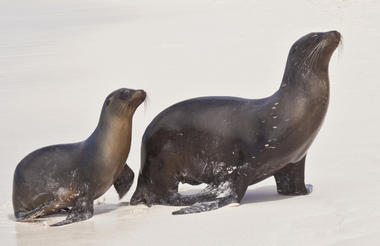
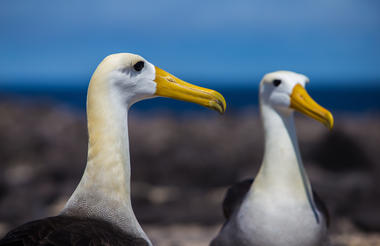
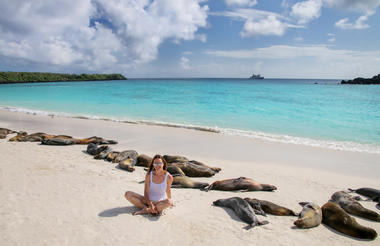
- Breakfast
- Lunch
- Dinner
Shake off any early morning doziness with a trip to Leon Dormido (Kicker Rock). This basalt crater rises 150 metres above the water and is divided into two parts by a narrow channel. Cruise around kicker rock as nesting seabirds flank the boat, tropicbirds soar overhead and sea lions lounge by the water. Next, spend some time snorkelling at Cerro Brujo, providing opportunities to see Galapagos sharks and sea turtles. Or perhaps enjoy the beautiful beach with a leisurely walk to photograph the interesting sea lions who can often be seen at this location.
Later, sail to Puerto Baquerizo Moreno on the island of San Cristobal. Some passengers will be leaving and others joining the group today, so you have some free time to explore the town of San Cristobal. In the afternoon you will visit the San Cristobal Interpretation Centre, which brings the history and geography of the archipelago to life, from its volcanic origins to the present day. If there’s time, your guide may be able to organise an optional visit to the highlands of San Cristobal, for a chance to see giant tortoises in the wild. The price of this optional activity depends on the number of passengers attending. Relaxing on the beach is a great option for those who don’t wish to partake in this excursion.



- Breakfast
- Lunch
- Dinner
Take a walk on Isla Santa Fe, home to a collection of the most spectacular wildlife in the Galapagos. You can expect to see sea lions, Galapagos hawks, land iguanas, a variety of finches, Galapagos mockingbirds, marine turtles, frigatebirds, Galapagos doves and lava lizards. Phew. The approximately 1.5-hour hike takes you along the coast and through a forest of opuntia (prickly pear cacti). The trail can be a little rocky, so mind your step and wear solid walking shoes. Later enjoy a snorkel in deep water and look out for schools of fish, rays and sea turtles.
Afterwards, continue to Isla Plaza Sur, a small, picturesque island. Take a walk (approximately 1.5 hours), getting close to sea lions and passing one of the Galapagos’ largest land iguana populations which rest among cacti. The southern cliffs of Plaza Sur are great for spotting tropicbirds and swallow-tailed gulls, as well as ‘the Gentlemen’s Club’ – a gathering of male sea lions. Today there may be an extra stop along the way to Plaza Sur to restock the provisions for the boat. Later tonight, set sail for Isla Genovesa.



- Breakfast
- Lunch
- Dinner
After an overnight sail, reach Isla Genovesa, the archipelago’s north-eastern outpost. It’s undeniably worth the voyage. Dolphins are often spotted in the waters here, so keep your eyes peeled. These varied landscapes are a twitcher’s paradise, with all three kinds of boobies, including the rare red-footed booby, making their home here. Next up is Bahia Darwin (Darwin Beach), another superb site with large breeding colonies of seabirds and frigates and other birds such as lava herons, swallow-tailed gulls, mockingbirds and, hopefully, vampire finches.
Enjoy a moderate walk (approximately 2.5 hours) that passes tide pools, sea lions and diamond stingrays. This walk involves sand and some rocky sections. The steep Prince Philip’s Steps lead you to the heart of the seabird rookeries, with birds overhead and nesting among the cliffs. Look out for storm petrels on the island’s rocky plains; Genovesa is the only place in the world where these birds can be seen flying during the day. Afterwards, perhaps cool off with a snorkel. The island’s magnificent marine life makes for spectacular snorkelling – you might encounter manta rays, sharks, turtles and moray eels, plus many species of fish.
Later tonight, depart Isla Genovesa for Isla Santiago.



- Breakfast
- Lunch
- Dinner
On Santiago Island’s eastern coast sits Bahia Sullivan. Take a walk along pahoehoe lava (approximately 1 hour), which was created by an eruption that occurred here in 1897. With some luck you might see some marine iguanas, Sally Lightfoot crabs, sea lions, finches, turtles, sharks and penguins. During your walk, as always, your naturalist guide will take you through the geological history of the island.
Travel to Cerro Dragon (Dragon Hill): one of the best places to see land iguanas in the islands. From our dry landing, walk to a brackish, lagoon spotting lagoon birds such as stilts, pintail ducks, sandpipers, sanderlings and flamingos. Further inland, the trail offers a beautiful view of the bay and the western area of the archipelago. This area is a nesting site for land iguanas, which is constantly monitored and assisted by the Charles Darwin Research Station. The arid-zone vegetation makes for an ideal place to see Darwin’s finches, Galapagos mockingbirds, the endemic Galapagos flycatcher and yellow warblers. The path can be challenging but it will be worth it for a spectacular view of the bay.
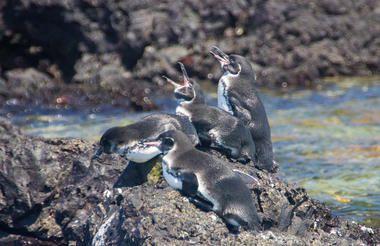

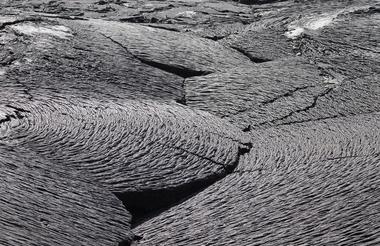
- Breakfast
- Lunch
- Dinner
Brave an early start to explore Caleta Tortuga Negra (Black Turtle Cove) on a Zodiac ride. This red mangrove wetland is located on the north shore of Isla Santa Cruz. A breeding area for green turtles, this is a good place to catch sight of them mating. There is also abundant bird life, such as the yellow warbler and lava heron. It is also a nursery for golden cow-nose rays, eagle rays and Galapagos sharks. This is your final excursion before you head to the airport in Isla Baltra for your flight back to Quito or Guayaquil.

- Breakfast








